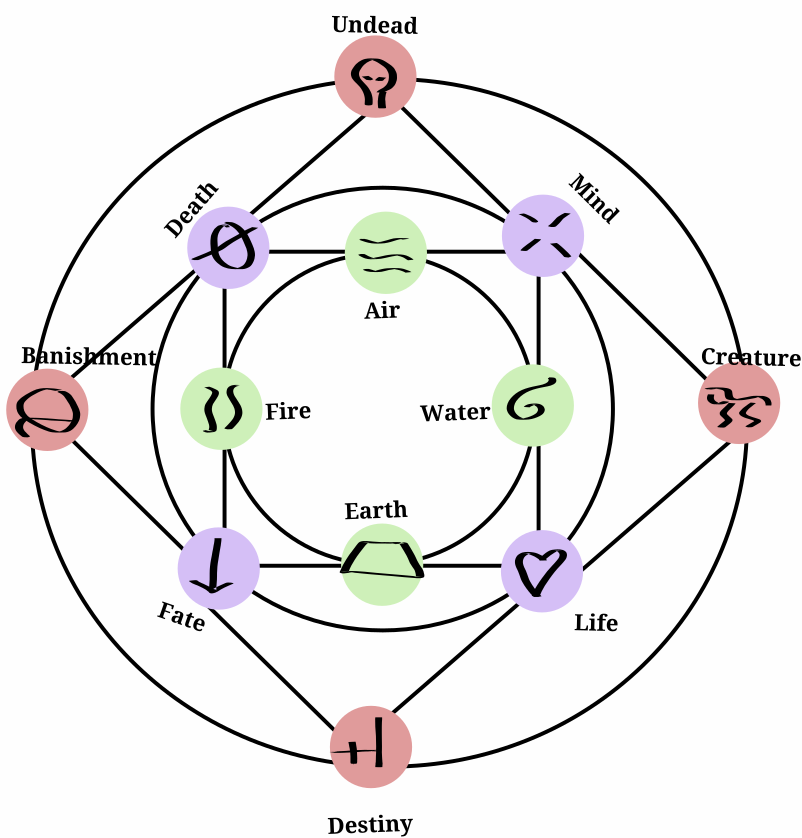Ritual meets perception meets reality; let’s talk magic. What’s your favorite original magic effect, and/or what’s one that you might want help with?
I’m making a magic system for an NSR/ OSR RPG. It has a few things on the ‘must have list’.
System Goals
- The system should have clear rules to make simple spells, so players can use simple spell lists, or make creative spells on-the-fly.
- Rules for making spells don’t have to be simple, because players will mostly just interact with the lists of spells.
- The system must have an underlying structure, and internal logic that makes sense in a Dark Ages setting.
- It has to produce a sizeable chunk of standard fantasy RPG magic tropes, like necromancy, clairvoyance, et c.
- The world should still ‘make sense’ - if spells impact trade and economics, then that’s okay, as long as the world remains coherent.
- You can’t make lots of gold with magic, if gold is used as coinage.
The System So Far
- Each sphere is one of the four classical elements.
- Mages buy Magic Spheres as skills (rated 1-3).
- E.g. Air 1, Fire 2.
- The mage can target that element with two effects:
- Detect/ Identify (e.g. ‘Detect water’)
- Alter (e.g. ‘alter fire’ and make a torch explode)
- Spend 1 additional mana point to ‘create’ something with magic (e.g. ‘Create rock’)
- Spend X additional mana to make the target ‘bigger’ (detect fire everywhere in a city, make all the air in the room noxious).
- Every sphere combination allows one additional target.
- Water + Earth lets you affect life, so you can ‘alter life’ (and give a cat wings) or ‘create life’ (and make thorny bushes grow).
- Every mechanic will have a standard effect, e.g.:
- If a spell can cripple someone, it will inflict a -1 penalty per Mana Point spent, to one Attribute.
- If a spell can grant the target Damage Resistance, it grants 1 per Mana Point spent.

The conceptual phase is taking a lot longer than I thought, and there’s a lot of work to be done.
I like some of the oddities (fire and light will have to lumped in together - I think this makes sense).
Some of the oddities I don’t like
- It has no teleportation magic.
- I don’t want healing magic, but the chart is just screaming ‘Water + Earth makes healing’.
And a lot of it needs to be conceptually tighter (the bottom left corner makes less sense than the top right corner).
I’ve tried climbing this mountain before, and I wish you luck. Here are a few of my notes, in case any of it is of use. This was meant to be a reproduction of the Mage:The Awakening spellcrafting system ported into the One Roll Engine by Greg Stolze:
Improvised Spellcasting
Creatively combine effects from your arcana and extra Spell Parameters for things like range, duration, and area of effect, until you’ve described exactly what your spell does. Each additional type of magic causes -1d to your dice pool.
Improvised castings are instantaneous, and involve a single roll. Combining Gnosis+Arcana (Use the highest Arcana that is part of this spell).
+1d for having a focus devoted to that arcana +1d for spending mana (up to 1) +1d for spending willpower (also 1 max) +1d if the spell coincides with your Vision, Belief, or Passion (These replaced Mission, Duty, and Craving in my homebrew)Extended castings are a higher investment, but higher payoff. It requires some kind of sacrifice - a significant object or a living creature. Each roll takes ten minutes*. To successfully cast the spell, a difficulty (1-10) and a needed number of successes (1-10) is set by the GM. I ran this as arbitrary, but feel free to have your own difficulty levels. For each interval of extended casting, you must spend willpower to continue attempting the spell.
+1d for a ritual with hour-long intervals +1d if your ritual involves several days prep time and/or significant materials costs +1d if the spell coincides with your Vision, Belief, or Passion (up to +3d)Improvised Spell Parameters
Long Distance Magic (Requires Space 2) For targets out of view. These spells require some object with a connection to the target. The penalty is based on the strength of its metaphorical connection, not the distance to the target.
Intimate -1d Familiar -2d Acquainted -3d Vague -4d Tenuous -5d
Multiple Targets Hits extra targets at full strength; The spell can now be Dodged, however.
Two -1d Four -2d Eight -3d… (Round up to nearest double)
Area The standard spell takes effect over a flat 1 yard radius. Double the penalty for the same cubic area. 2 yard radius -1d 4 yard radius -2d… (Et cetera, round up to nearest double)
Duration The effect maintains over Width or Height in the relevant time scale, per GM. Some effects might not be able to extend over time, or extend differently.
Minutes -1d Hours -2d Days -3d Years -4d Forever -5d
Misc Spell Modifiers Pick one per extra Mana spent, up to three.
Casts in Minutes +2d Casts in Hours +3d Causes 1S to caster’s entire body +1d
Repeats Effect Next Round -2d Must be cast after success with an other skill +1d
Difficult (-2d) to Counterspell -2d
Ignores X armor -2X Can be blocked by armor +1d
Spell effect covers a ~150 ft radius -3d
Summons one Threat 2 Creature -1d
Spell requires unusually complex ingredients and preparation +2d
Fantastic suggestions, cheers for the write-up.
General principles are good - with the right design the entire thing should reduce to a flowchart and some tables.
…and then we have magical items and areas, so plenty to conceptual work to do. It’s turned into a mammoth discussion on the board.
- The system should have clear rules to make simple spells, so players can use simple spell lists, or make creative spells on-the-fly.
Here’s one that I’m exceptionally pleased with. I managed to steal from Star Trek, Robocop, and The Matrix all with one obscure paper magic spell: The Inkbound Phantome. This spell is merely one part of the process to forever entrap a spirit in the pages of a book, even allowing you to intrude on the charade.
Within the pages of a phantome a timeless hell unfurls. The boundaries of storytelling and magic blur to create a false dream that ensnares spirits, demons, and lost souls. Bound within the book’s enchantment, they become unwitting actors in a theatre of the mind, playing out the drama every time the book is read anew. The ink itself dances and shifts with every reading. The actual story and the physical circumstances of the entrapped entities are determined by the creator of the phantome. It is easiest to create a fictional tale, but it can also be an attempt to recreate true events. However, inkbound prisoners are only able to respond naturally to circumstances as dictated by their jailors.
These books are more than just a dark diversion, however. They can be read like a normal book, but Spice Rangers have also discovered that reading a phantome in conjunction with tincture of nilmahal and rabt-ke-patta, which together create vivid and spiritual dreams, one enters a dream realm that mimics the story. This can be thrilling and profound. They can bend the story and shape it around themselves, but if they break character the prisoners can awaken and perhaps escape into the reader’s mind. This can be especially dire when the prisoner is Demonic…
Phantomes contain a world of endless possibilities, where readers become both witnesses and participants in a tale that transcends time. The ink flows, the imprisoned spirits awaken again for a time, and the readers, with each turn of the page, indulge in an enchanted realm of words.
Process
First, Create Ink of Binding. Then, the magician must use it to write a book that defines the circumstances at play in the story, the character(s) that the imprisoned spirits will inhabit, detailing their personalities, memories, abilities, habits, and preferences, and the major events of the story. The number pages that are incorporated determines how many prisoners it can contain. To the imprisoned, a lengthier and more detailed manuscript will create a more credible illusion. Too few pages, and the characters will see through their charade and find it ridiculous. An overly simple or badly written manuscript will lead prisoners to rebel or go mad. Third, the bindings of the book must be obtained. Bones from a Vvurm are preferred, but the remains of any magical beast will suffice in creating the hard cover and spine. The pages of the manuscript are bound within this vessel, and then the phantome is ready to receive its inmates. A spirit, demon, or human soul must be captured and bound to the object. This spell does not do that, it merely creates the vessel.
Notes
It seems very likely that books such as these would be the perfect device for creating a daemonhost. All one needs to do is imprison the demon in the phantome along with the soul of the target host (with the vivid reading tincture), casting each in a story where the human willingly becomes a shadow, forsaking the light of Karna - and offering their body to the Demonic spirit in exchange for its allegiance to the author of the book. The trick is to end the dream at the correct moment, so that the agreement concludes in the vivid realization of what has been done. Daemonhosts in this setting always preserve the human soul within the host’s shadow, and a bit like Peter Pan’s shadow the human soul remains aware and able to move freely. They often try to interfere with the daemonhost, but the evil spirit who inhabits their body is able to physically interact with the shadow.
Also it is difficult to learn magic in the lands of Karnum, where the truth has no path. One of the ways to learn sorcery is to create a phantome with a nature spirit, or a demon, and place them in a story that would plausibly give them a reason to teach magic. A common storytelling device is to cast them as a lonely sorcerer or witch who falls in love with a wanderer, and offers to teach them magic in order to woo them. The reader must first read the book so that they can play the part convincingly, and then dream with the demon in hopes of receiving the true lessons. It is possible that the cambion Maerlyn D’Ambrosio was conceived in this way.
There are also judicial applications of the phantome. Imagine being sentenced to have your soul imprisoned in a phantome alongside scores of other condemned, and the story is an attempted prison break - only to have the prisoners discover the horrible truth at the end, again and again. Imagine again that you have been drugged with the dreaming tincture, and sentenced to read such a book. Some phantomes are used in the judicial process - severe punishment involves being sacrificed and turned into an inkbound along with hundreds of others. Each month your book, which is a tale of torment, is reread. You relive the suffering anew, and then a page is torn out which makes the illusion slightly less believable upon the next reading. This continues until the story collapses and you get to watch it all happen from a remove. Each retelling gradually makes the suffering more of a farce. Eventually the story ceases to make sense, and you lose your mind, and then your soul is released. One of the lighter punishments is being forced to read the book. A harsher punishment involves using the tincture and experiencing the torture along with the souls.
As a further aside, I came up with this idea because I loved the way Kitsune in Werewolf can use paper magic to create false worlds, and I wanted to make something that resonated with the feeling you get when you get lost in a book - or the haunting experience of having a character from a novel feel as if they’ve escaped into your head. I was also thinking about holodecks when I came up with the idea, but I wasn’t happy with how being in a holodeck lowers the stakes of the story artificially (and then artifically raises them again when you deactivate the safety features - that’s cheating). The stakes involved in a phantome are based in its circumstances - the actual prisoners waking up and entering your mind, or if the pages get damaged the story doesn’t have enough room to unfold properly and they start to pick at the edges of your false reality. I would love holodecks as a real technology, but as a storytelling device all the tension is undercut by the knowledge that it’s all simulated and any stakes can be negated by a toggle switch (deus ex machina). Phantomes are meant to be more along the lines of The Matrix, except in this case the protagonist is the jailor and the erstwhile baddies are the sleepwalking inmates. A demonic spirit could become like a “Neo” and try to liberate the other spirits in the book, but they would still be the baddie. It puts the good guys into a questionable moral position and a tenuous position of power at the same time, which is always a fun circumstance to investigate. I was also drawing from history in a sense, because part of what inspired me was the ancient Roman legal proceeding of a “fatal charade”, in which the condemned is forced to put on a play where their character’s death is carried out on stage in truth. Of course, for an inkbound spirit condemned in this way, the punishment can be repeated as often as anyone can be bothered to read the passage.
@Gradually_Adjusting Interesting concept! I like the moral twist of an inverted Matrix. As an aside, I know you said where you got your inspiration, but I can’t help but be reminded of children’s books like Inkheart and The Neverending Story. There’s just something about stories coming to life (and trapping you).
Thanks! I admit I forgot to check tvtropes when I was writing it. Turns out, the closest thing to it was an episode of Futurama. Not bad!



